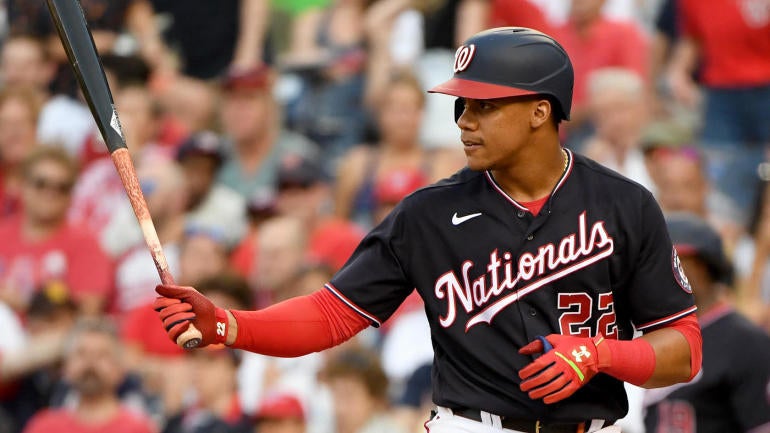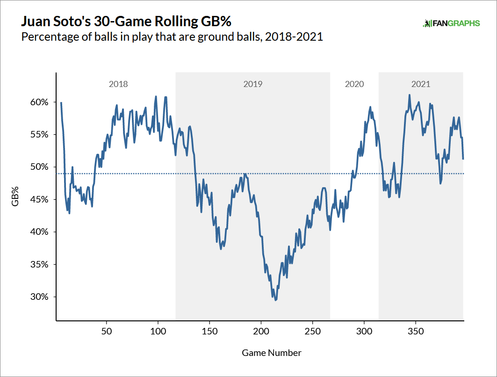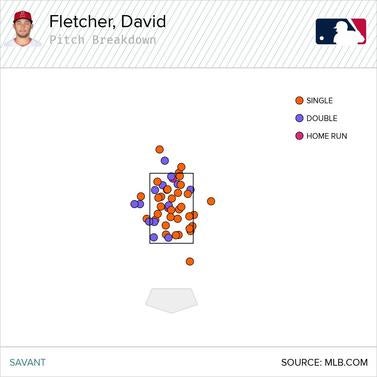
The All-Star break is in the rearview mirror and the chaos of the trade deadline is next week. We're in crunch time now. We've reached the second half of the season and the dog days of the summer are right around the corner.
Our weekly series examining various trends across the league continues with a hitter who has taken off since the Home Run Derby, a struggling former MVP, and a player who just wrapped up a long hitting streak. Last time we looked at Joey Gallo's hot streak, Dylan Cease's breakout, and Bobby Bradley's power.
Soto's extended Home Run Derby
The post-Home Run Derby slump is a myth that has been debunked many times over. Pick eight players at random and chances are a few will perform worse in the second half than they did in the first half. That's just baseball. We like attaching narratives to things though, so the post-Home Run Derby slump persists.
Fortunately, Nationals wunderkind Juan Soto is here to craft a new narrative. Soto bested Shohei Ohtani in a memorable two-tiebreaker first-round matchup in the Home Run Derby last week, and he hasn't stopped mashing taters since. In five games since the All-Star break, Soto has slugged five homers, with two two-homer games. He hit 11 homers in 79 games prior to the All-Star break.
Soto's power was down in the first half -- those 11 homers came with a .445 slugging percentage, which certainly isn't bad, though it is well below .557 slugging percentage he posted from 2018-20 -- because he was simply hitting too many ground balls. The next ground ball I see go over the fence will be the first, and Soto put nearly 60 percent of his balls in play on the ground in the first half.
Here is Soto's ground ball rate throughout his MLB career. It was elevated his rookie season, which isn't surprising considering he was a 19-year-old who essentially jumped from Single-A ball to the big leagues, then it dipped in 2019 and early in the shortened 2020 season. The MLB average is a 43.3 percent ground ball rate.

Going into the All-Star break, Soto said he hoped the Home Run Derby would fix his swing because he had been hitting too many ground balls, and it was cutting into his power. Imagine that? An elite hitter hoping the Home Run Derby would fix his swing despite the prevailing narrative that it ruins swings and causes second-half funks.
"It might mess with the swing of all the guys that are locked in, but I think it's going to fix mine because I'm hitting too many ground balls," Soto told reporters, including MLB.com's Jessica Camerato, prior to the All-Star break. "I hope it fixes my swing trying to put the ball in the air. That's what we've been trying the whole year, so I hope it fixes mine."
Well, mission accomplished. Soto has cut his ground ball rate from 55.0 percent in the first half to 42.9 percent in the second half, roughly on par with his 2019 ground ball rate (41.9 percent), and now the home runs are coming in droves. Even during the first half, Soto was an elite exit-velocity guy. He crushes the ball. And now that he's getting it in the air more often, his power has returned, and he can thank the Home Run Derby for fixing his swing.
"I just feel so much better now," Soto told Camerato this past weekend. "I was thinking about it, and it really helped me a little bit get that feeling of how to put the ball in the air and everything. I tried everything I could in the first half, and the ball still was going to the ground ... I think the Derby helped me out big time. It's just kind of impressive, though, because I didn't realize how quickly it was going to help me out. To see those homers in this series, it was great for me."
Bellinger's fastball problems
Coming into the season, the defending World Series champion Dodgers were again expected to win the NL West, which would give them nine straight division titles. They are currently in second place and within striking distance of the first-place Giants, and one key reason they're not in first place is Cody Bellinger. He's been hurt and ineffective this season.
Bellinger missed close to two months with a hairline fracture in his left leg after a seemingly mild collision at first base in his team's fifth game of the season, and then missed about two weeks with a hamstring issue last month. In 39 games around the injuries, Bellinger has hit a weak .161/.282/.270 with the highest strikeout (27.0 percent) and swinging strike (13.7 percent) rates of his career. It has been a battle all year.
"He's grinding," Dodgers manager Dave Roberts told reporters, including The Athletic's Fabian Ardaya, earlier this week. "For Cody, when he was really good in '19, he was a hitter first and the slug followed. He was using left-center, was using the middle of the field, right-center field, and then on breaking balls in the zone, he would slug those to the pull side. So I think, for me, if he could go back to being a hit collector using both gaps, I think that's a great start."
Bellinger's problems are numerous. He's hitting a ton -- a TON -- of popups, suggesting he's gotten too long and too uppercutty with his swing. All those popups are easy outs, hence Bellinger's career worst .198 batting average on balls in play. Also, after hitting a home run on 21.2 percent of his fly balls from 2017-20, it's only 9.1 this year. Popups are production killers and Bellinger's frustration is showing. From this past weekend at Coors Field:
There have also been problems with the fastball. Bellinger is hitting a weak .141 with a .333 slugging percentage against fastballs this season. The MLB averages are .262 and .441, respectively, and during his MVP season in 2019, Bellinger hit .327 and slugged .661 on fastballs. Also, Bellinger is missing with 27.5 percent of his swings against fastballs. It was 19.7 percent from 2019-20 and the MLB average is 21.2 percent.
Everything in this game starts with the fastball. If you can't hit it, you're pretty much useless at the plate in an era in which every pitching staff has multiple guys throwing 95-plus mph. And if you can't command the fastball, you're going to have a hard time carving out a consistent role on the pitching staff. Right now, Bellinger can't hit the fastball, and he's popping up way too many hittable pitches rather than driving them on a line.
Bellinger is a tinkerer and he's tinkered with his batting stance in recent weeks. Most notably, he's spread his legs a bit and opened his stance more, giving him a wider base. It hasn't worked, but he's trying. Bellinger's struggles are not the result of a lack of effort. He got a late start on spring training following offseason shoulder surgery, then had his season interrupted by two injuries. As he gets more at-bats under his belt, he should look more like the real Cody Bellinger, and the Dodgers need it to happen soon.
"I see some really good at-bats in there, I see some at-bats that are not so good," Roberts recently told reporters, including Blake Williams of Dodger Blue. "So I think for Cody, it's just more of the abbreviated spring training, the start-stop with the season, and hitting is hard."
Fletcher's hitting streak
Very quietly, Angels infielder David Fletcher just wrapped up MLB's longest hitting streak in two years, and the second-longest hitting streak in franchise history. Fletcher's 26-game hitting streak came to an end with an 0 for 5 against the Mariners on Sunday. He struck out three times for the only fifth time in his career.
"No doubt, he is a confident young man," Angels manager Joe Maddon told reporters, including the Associated Press, after Fletcher extended the hitting streak to 26 games Saturday. "I think there's Joe Namath, and then there's David Fletcher. Two tremendous lore-like heroes. He's got that thing. There's nothing on that baseball field that he doesn't think he can do. The lore of David Fletcher is beginning."
Fletcher's 26-game hitting streak trails only Garret Anderson's 28-gamer in 1998 in Angels history. Hall of Famer Rod Carew (25 games in 1982) is the only other player with at least a 25-game hitting streak for the franchise. Here are MLB's last five 26-plus game hitting streaks:
- David Fletcher, Angels: 26 games (June 13 to July 17, 2021)
- Wilson Ramos, Mets: 26 games (Aug. 3 to Sept. 3, 2019)
- Whit Merrifield, Royals: 31 games (Sept. 10, 2018 to April 10, 2019)
- Freddie Freeman, Braves: 30 games (Aug. 24 to Sept. 28, 2016)
- Xander Bogaerts, Red Sox: 26 games (May 6 to June 2, 2016)
The longest hitting streak in baseball history of course belongs to Hall of Famer Joe DiMaggio. DiMaggio faced 54 different pitchers during his record 56-game hitting streak in 1941. Fletcher faced 60 -- 60! -- different pitchers during his 26-game hitting streak. That has as much to do with modern pitcher usage as it does DiMaggio playing in an eight-team league with no interleague play.
Anyway, Fletcher has a very unique skill set given his extremely low strikeout rate (10.6 percent) and extremely low average exit velocity (83.7 mph). He slaps the ball all around the field and he can get his bat on the ball no matter where it's pitched. Fletcher had 49 hits during the 26-game hitting streak, and look at the pitch locations:

Up, down, in, out, wherever. Fletcher can get the bat on the ball anywhere. He hit .454/.468/.630 during the 26-game hitting streak, which raised his season batting line from .255/.287/.294 pre-hitting streak to .318/.344/.399 post-hitting streak. Only eight times in the 26 games did Fletcher strike out, and he had multiple hits 13 times in the 26 games.
The Angels have hung around the postseason race even with Mike Trout and Anthony Rendon on the injured list thanks to Ohtani's two-way brilliance, first and foremost, and also because Fletcher has been one of the best players in baseball the last month or so. He's a contact machine and an excellent defender, and the sort of pesky hitter who lengthens the lineup when the Angels are at full health. Over the last month, Fletcher has been even better than that. He's produced at a star level.






















